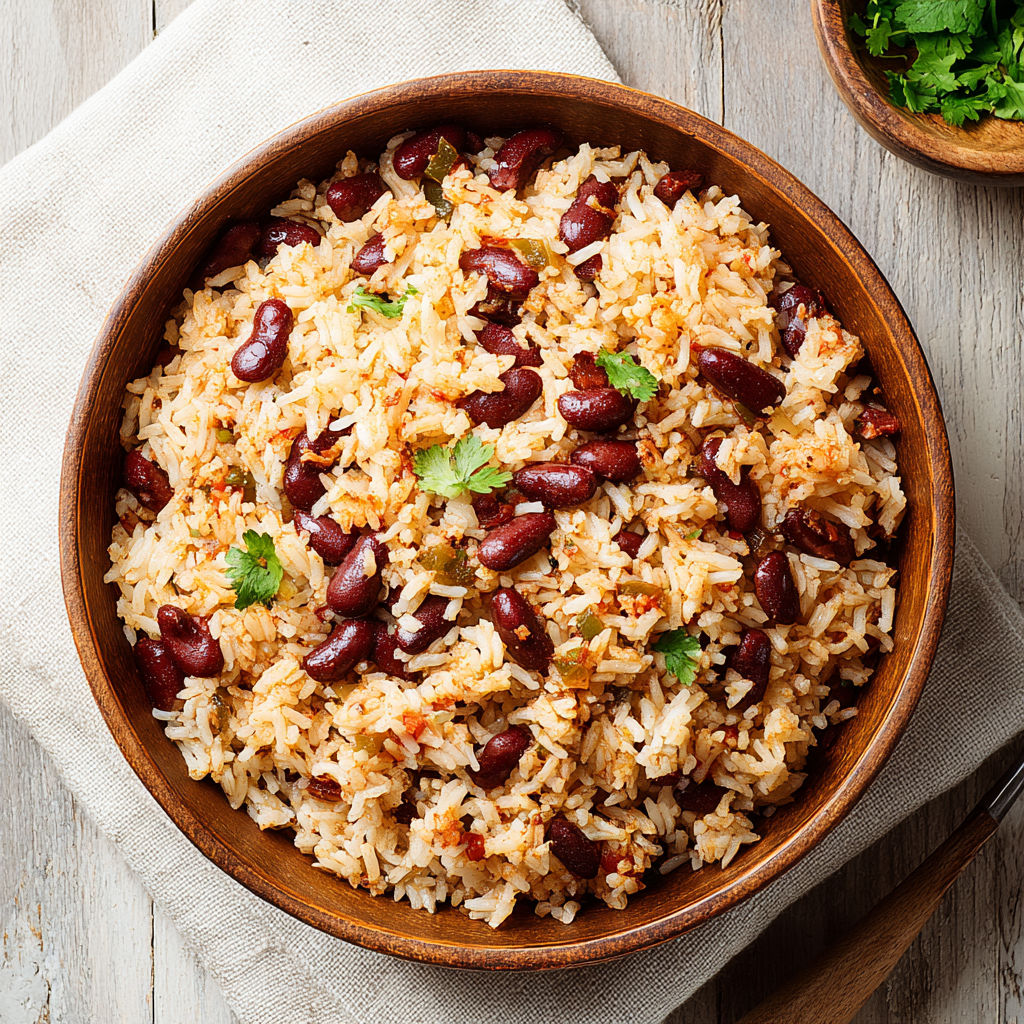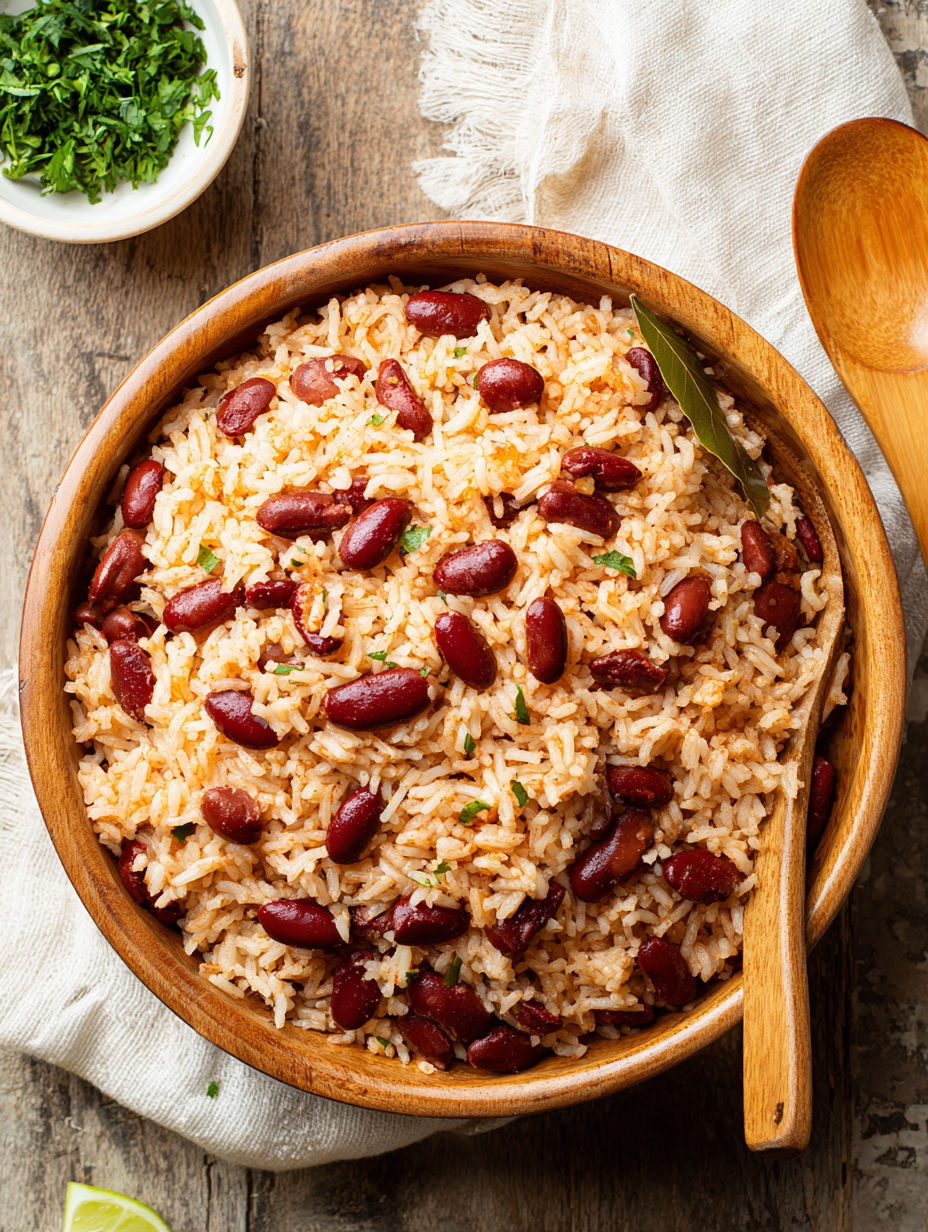 Pin to Save
Pin to Save
Dominican moro de habichuelas rojas is a comforting and flavorful onepot meal combining rice and red beans with a fragrant blend of sazón, culantro, and achiote. It’s a perfect dish for family gatherings or holiday celebrations and it comes together easily, making it ideal for sharing with loved ones.
I first made this during a family reunion, and it quickly became a favorite, with everyone asking for the recipe. The combination of spices and beans makes it uniquely comforting and nostalgic.
Ingredients
- Vegetable oil: Two tablespoons vegetable oil, chosen for its neutral flavor and high smoke point
- Red onion: One small red onion finely diced, for sweetness and depth
- Green bell pepper: One small green bell pepper diced, adding freshness and a mild bite
- Garlic: Three cloves garlic minced, essential for aromatic foundation
- Sazón seasoning: One packet sazón seasoning mix with coriander and annatto, which adds color and authentic Dominican flavor
- Dried oregano: One teaspoon dried oregano for herbal notes
- Ground cumin: One teaspoon ground cumin for earthiness and warmth
- Black pepper: Half teaspoon freshly ground black pepper to balance the spices
- Salt: One and a half teaspoons salt, adjust to taste
- Tomato sauce: Quarter cup tomato sauce to add tang and body to the dish
- Red kidney beans: One can fifteen ounces red kidney beans with liquid, providing creaminess and protein
- Long grain white rice: Three cups raw longgrain white rice, rinsed to remove excess starch and ensure fluffy grains
- Vegetable broth: Four cups vegetable broth, which infuses the dish with savory depth
- Bay leaves: Two bay leaves for subtle herbal aroma throughout cooking
Instructions
- Prepare the aromatic base (sofrito):
- Heat the vegetable oil in a large heavybottomed pot over medium heat until shimmering. Add the finely diced red onion and green bell pepper. Stir frequently for about two to three minutes until onions become translucent and soft, which helps to develop a mellow, sweet base. Add the minced garlic and sauté for an additional minute, taking care not to let the garlic brown as this would add bitterness.
- Layer the seasonings:
- Sprinkle in the sazón seasoning mix along with the dried oregano, ground cumin, black pepper, and salt. Stir continuously for about thirty seconds to allow the spices to bloom and release their full aromas, which creates a more vibrant flavor profile.
- Incorporate tomato and beans:
- Pour in the tomato sauce and cook for one to two minutes while stirring to cook off any raw tomato taste. Then add the can of red kidney beans including their liquid. Mix thoroughly to combine the ingredients evenly, which builds richness and depth in the dish.
- Add rice and liquids:
- Add the rinsed longgrain rice to the pot and stir well to coat every grain in the flavorful sofrito and seasonings. Next, pour in the vegetable broth and add the bay leaves. Increase the heat to bring the mixture to a gentle boil, stirring occasionally to prevent rice from sticking to the bottom of the pot.
- Simmer and cook rice:
- Once boiling, reduce the heat to low and cover the pot tightly. Allow the rice to simmer undisturbed for twenty minutes. Avoid lifting the lid during this time to maintain even steam circulation and perfectly cooked rice. After twenty minutes, check the rice; the liquid should be absorbed and the grains tender yet separate.
- Rest and fluff:
- Remove the pot from heat and let it sit covered without stirring for an additional five minutes. This offheat resting phase lets the rice finish steaming gently for a better texture. Discard the bay leaves, then fluff the rice carefully with a fork to separate the grains before serving.

My favorite ingredient here is the sazón seasoning mix with its vibrant combination of coriander and annatto. It’s not just about seasoning but also about creating that warm golden color that makes the dish visually inviting. I remember serving this dish at a holiday party, and someone asked if it was yellow rice, making me smile because the sazón does its job beautifully both in color and flavor.
Storage Tips
Cool the moro completely before transferring it to airtight containers. Stored in the fridge, it will keep well for up to four days. When reheating, add a splash of vegetable broth or water to bring back moisture and fluffiness. This method ensures the rice does not dry out or become clumpy.
Ingredient Substitutions
Vegetable oil can be swapped for coconut oil for a subtle tropical aroma and a touch of sweetness that complements the beans and spices. If you don’t have red kidney beans, pinto beans work wonderfully as they yield a creamier texture while maintaining the hearty essence of the dish. Use brown rice instead of longgrain white rice to add an earthy, nutty flavor and extra fiber though cooking time will increase by 10 to 15 minutes so adjust the liquid accordingly.
Serving Suggestions
A quick garnish of fresh chopped cilantro or a squeeze of lime juice brightens the rich flavors and adds freshness. Pair the dish with crispy fried plantains for contrasting textures or a simple avocado salad for a creamy complement to create an authentic Dominican dining experience.

This moro is a simple soulful dish that brings warmth and comfort to any table. Serve with lime and cilantro for a bright finish.
Common Questions About Recipes
- → Why is my rice sticky or mushy?
Excess liquid or lifting the lid during cooking traps moisture, causing sticky rice. Measure liquids accurately and keep the lid closed until done.
- → Can dried beans replace canned beans?
Yes, soak and cook dried beans fully before use, reserving some cooking liquid to maintain texture and flavor similar to canned beans.
- → What if the rice is undercooked after resting?
Add a few tablespoons of hot broth or water, cover again, and steam on low heat for 5 more minutes until tender.
- → How can I add a smoky depth?
Incorporate a pinch of smoked paprika or a splash of liquid smoke with the tomato sauce for subtle smoky notes.
- → Does this dish freeze well?
Yes, allow to cool completely before storing airtight for up to one month. Reheat gently with added water or broth to retain moisture.